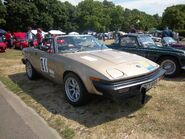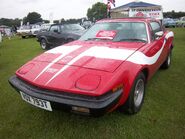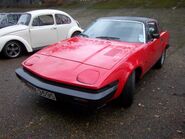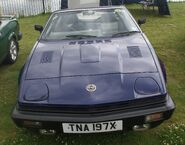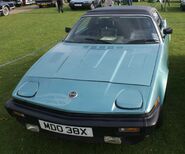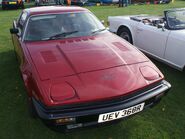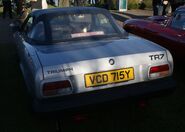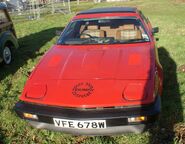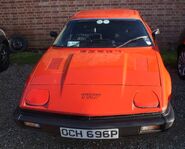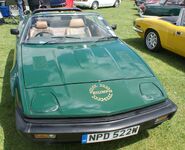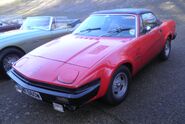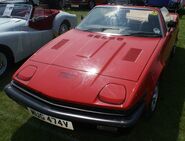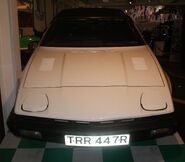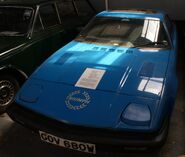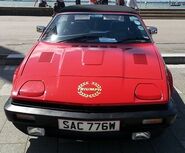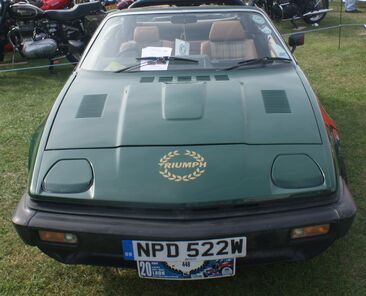
Triumph TR7
The Triumph TR7 is a sports car manufactured from September 1974 to October 1981 by the Triumph Motor Company (which was part of British Leyland) in the United Kingdom. It was initially produced at the Speke, Liverpool factory, moving to Canley, Coventry in 1978 and then finally to the Rover plant in Solihull in 1980. The car was launched in the United States in January 1975, with its UK home market debut in May 1976. The UK launch was delayed at least twice because of high demand for the vehicle in the US.
Design, features and variants[]
The car was characterized by its "wedge" shape, which was commonly advertised as: "The Shape of Things to Come", and by a curved line in the bodywork sweeping down from the door area to the rear of the car. The design was penned by Harris Mann who also designed the wedge-shaped Leyland Princess. The car had an overall length of 160 inches (406 cm), width of 66 inches (168 cm), wheelbase of 85 inches (216 cm) and height of 49.5 inches (126 cm). The coupé had a kerbside weight of 2205 pounds (1000 kg). During development, the TR7 was referred to by the code name "Bullet".
Power was provided by a 105 bhp (78 kW) (92 bhp (69 kW) in the North American version) 1998 cc 8-valve four-cylinder engine which shared the same basic design as the Triumph Dolomite Sprint engine mounted in-line at the front of the car. There were plans to directly use the Sprint engine 127 bhp (95 kW) in the TR7 and at least 25 pre-production cars were made in 1977 using the 1978 model year bodyshell. This model was getting ready for full production until the closure of the Speke Plant. These cars, of which several still exist in the UK, can be identified by a different chassis number to the production 8-valve model. Drive was to the rear wheels via a four-speed gearbox initially with optional five-speed manual gearbox or three-speed automatic from 1976. The front independent suspension used coil spring and damper struts and lower single link at the front, and at the rear was a four link system again with coil springs. There were front and rear anti roll bars, with disc brakes at the front and drums at the rear.
Various British Leyland vehicles were driven by the lead characters in the British secret agent television series The New Avengers, produced between 1976 and 1977. Amongst these was a yellow TR7 hardtop driven by the character Purdey. The car was immortalised as a children's Dinky Toy and Revell construction kit.
In 1978 Coca-Cola and Levi's ran promotional competitions with the top prizes being three TR7s in special red and white Coke livery. They also featured denim upholstery and genuine jean patch pockets on the door interiors. Also included were a 12V fridge in the boot and a TV in the glove compartment. To win one of those cars, the competition entrants had to find as many words as possible in the phrase 'All Summer'. They had to be at least four letters long, singular and not a proper noun. The winner, an accountant, found 315 words to the runner-up's 314. Two of these cars still exist (one is in the gallery below).
For import to the US market, Triumph created a more powerful Triumph TR8 model in 1977/78, this was a TR7 with a 135 bhp (101 kW) 3.5 L Rover V8 engine. While some genuine TR8s stayed in Britain, these examples are exceedingly rare. Most TR8s went to the US, where they did not fare well due to both Triumph's poor build quality at the time and the unusually strong pound which peaked at around $2.40 by 1980, making Triumphs fairly expensive compared to competitors.
Because of US legislation in places at the time of its launch, the TR7 was not initially available as a convertible. In early 1979, Triumph belatedly introduced a convertible version, called the TR7 Drophead, which first went on sale in the US. The British market received it in early 1980. The prototype for the convertible version of the original Harris Mann design came from Michelotti and the engineering to make it work was done by Triumph. In the UK in 1980, the TR7 Drophead sold for £5,050, whilst the Coupé sold for £5,230.
In 1980, a limited edition TR7 Drophead was launched for the US market. Called the TR7 Spider, its was available only in black, with reflective red striping and badging. Alloy wheels and the steering wheel from the TR8 were fitted, along with a "pewter grey" carpet and grey striped upholstery. It is thought around 1270 Spiders were build at the Solihull factory.
As of Q1 2011 there were approximately 748 licensed and 1947 SORN TR7's registered with the DVLA.
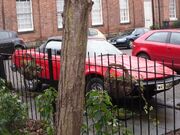
1981 Triumph TR7 Roadster – RWK 946W This TR7 Roadster was in good condition when it was spotted in Darley Abbey on the 7th of January 2013. This particular car was made in 1981 and it was first registered in the UK, in the same year, on the 1st of April 1981. It has the original 2.0 Litre (1998cc) Straight 4 engine which runs on petrol. The car was uncovered but is usually kept under a cover and was spotted on a rare fine day.
Motorsports[]
British Leyland ran a team of TR7s in rally competitions from 1976 to 1980. These cars initially used the 16-valve Dolomite Sprint engine and later switched to the Rover V8 engine (before the introduction of the TR8, so dubbed "TR7V8"). They were reasonably successful on tarmac events but were less successful on gravel sections. The most successful driver of these cars was Tony Pond.
John Buffum won the SCCA PRO Rally Championship from 1977–1980 driving TR7s and TR7V8s.
The TR7-V8s continue to be successful in classic rallying events.
Quality problems[]
Quality problems tended to undermine the car's image in the market place. This was primarily the result of labor strife and inexperienced workforce at the Speke factory. Quality improved when production was moved to Canley and later Solihull, but it was too late to save the car's reputation.
In its Frankfurt Motor Show preview edition of September 1977, the motor magazine Auto, Motor und Sport reported that the engine of a TR7 press car had given up the ghost and "started to boil" while undergoing a maximum speed measurement exercise over a four-kilometer stretch of track as part of a road test. At the time of the report the cause of the problem was still unknown; British Leyland technicians had already been investigating the car, without comment, for nineteen days.
Production volumes[]
In total, 112,368 hardtop TR7s were built with an additional 28,864 softtop/convertibles, and approximately 2,500 V8 engined TR8s. As part of a rationalisation introduced by BL boss Sir Michael Edwardes, the Triumph TR7 was axed in 1981.
Cancelled variants[]
A variant of the TR7 powered by the Dolomite Sprint engine (dubbed the TR7 Sprint) was developed, but never put into production because of labor problems at the Speke factory and the factory's subsequent closure.
Lynx[]
While the TR7 was under development in the early 1970s, a 2+2 fastback derivative, codenamed Lynx was also planned. The Lynx had a wheelbase stretched by 12 inches (300 mm), the Rover V8 engine, with the rear axle from the Rover SD1. Scheduled for launch in 1978, the Lynx was cancelled when the Speke factory was closed.
Broadside[]
In early 1979, a joint MG/Triumph project to produce a new sportscar based on the TR7 was started under the name Project Broadside. This was based on the TR7, with a wheelbase stretched by 5 inches (130 mm), with either an O-Series or Rover V8 engine, and both drophead and fastback body styles. Project Broadside was cancelled later in 1979, due to a lack of funding.
Boxer[]
During the latter part of 1979, as an exercise in badge engineering, another MG version of the TR7 was developed under the codename Boxer as a potential replacement for the MGB. Various concepts were presented and ultimately a design from BL's American headquarters at Leonia was accepted. Major changes to the standard TR7 Hardtop were the addition of a MG type grille to the nose panel, headlights similar to those of a Porsche 928 and a new tail panel with light units from a Rover SD1. The proposal was ultimately rejected on the grounds that the car was insufficiently different from the TR7.
Gallery[]
| Triumph vehicles | |
|---|---|
| Classic production cars
|
|
| Classic racecars
|
|
| Classic concept cars
|
|

